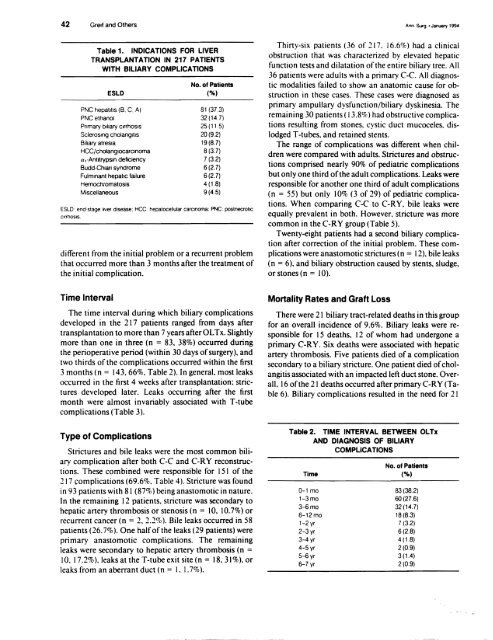Download (869Kb) - D-Scholarship@Pitt - University of Pittsburgh
Download (869Kb) - D-Scholarship@Pitt - University of Pittsburgh
Download (869Kb) - D-Scholarship@Pitt - University of Pittsburgh
You also want an ePaper? Increase the reach of your titles
YUMPU automatically turns print PDFs into web optimized ePapers that Google loves.
42 Gretf and Others<br />
Table 1. INDICATIONS FOR LIVER<br />
TRANSPLANTATION IN 217 PATIENTS<br />
WITH BILIARY COMPLICATIONS<br />
ESLD<br />
PNC hepatitis (B, C, A)<br />
PNC ethanol<br />
Primary biliary cirrhosIs<br />
ScleroSing cholangitis<br />
Biliary atresia<br />
HCC/cholanglocarclnoma<br />
a,·Antitrypsin deficiency<br />
Budd·Chiari syndrome<br />
Fulminant hepatic failure<br />
Hemoclvomatosls<br />
Miscellaneous<br />
No. <strong>of</strong> Patients<br />
(%)<br />
81 (373)<br />
32 (14.7)<br />
25(11.5)<br />
20(92)<br />
19(8.7)<br />
8 (3.7)<br />
7 (3.2)<br />
6(2.7)<br />
6 (2.7)<br />
4 (1.8)<br />
9(4.5)<br />
ESLD: end'stage lIVer disease; HCC hepalocellular carcinoma; PNC: postnecrOtlC<br />
ClfrhOSIS<br />
different from the initial problem or a recurrent problem<br />
that occurred more than 3 months after the treatment <strong>of</strong><br />
the initial complication.<br />
Time Interval<br />
The time interval during which biliary complications<br />
developed in the 217 patients ranged from days after<br />
transplantation to more than 7 years after OL Tx. Slightly<br />
more than one in three (n = 83. 38%) occurred during<br />
the perioperative period (within 30 days <strong>of</strong> surgery). and<br />
two thirds <strong>of</strong> the complications occurred within the first<br />
3 months (n = 143.66%. Table 2). In general. most leaks<br />
occurred in the first 4 weeks after transplantation: strictures<br />
developed later. Leaks occurring after the first<br />
month were almost invariably associated with T-tube<br />
complications (Table 3).<br />
Type <strong>of</strong> Complications<br />
Strictures and bile leaks were the most common biliary<br />
complication after both C-C and CoRY reconstructions.<br />
These combined were responsible for 151 <strong>of</strong> the<br />
217 complications (69.6%. Table 4). Stricture was found<br />
in 93 patients with 81 (87%) being anastomotic in nature.<br />
In the remaining 12 patients. stricture was secondary to<br />
hepatic artery thrombosis or stenosis (n = 10. 10.7%) or<br />
recurrent cancer (n = 2,2.2%). Bile leaks occurred in 58<br />
patients (26.7%). One half <strong>of</strong> the leaks (29 patients) were<br />
primary anastomotic complications. The remaining<br />
leaks were secondary to hepatic artery thrombosis (n =<br />
10, 17.2%), leaks at the T-tube exit site (n = 18,31%), or<br />
leaks from an aberrant duct (n = I, 1.7%).<br />
Ann. Surg .• January 1994<br />
Thirty-six patients (36 <strong>of</strong> 217, 16.6%) had a clinical<br />
obstruction that was characterized by elevated hepatic<br />
function tests and dilatation <strong>of</strong> the entire biliary tree. All<br />
36 patients were adults with a primary C-c. All diagnostic<br />
modalities failed to show an anatomic cause for obstruction<br />
in these cases. These cases were diagnosed as<br />
primary ampullary dysfunction/biliary dyskinesia. The<br />
remaining 30 patients ( 13.8%) had obstructive complications<br />
resulting from stones, cystic duct mucoceles, dislodged<br />
T-tubes, and retained stents.<br />
The range <strong>of</strong> complications was different when children<br />
were compared with adults. Strictures and obstructions<br />
comprised nearly 90% <strong>of</strong> pediatric complications<br />
but only one third <strong>of</strong> the adult complications. Leaks were<br />
responsible for another one third <strong>of</strong> adult complications<br />
(n = 55) but only 10% (3 <strong>of</strong> 29) <strong>of</strong> pediatric complications.<br />
When comparing C-C to CoRY, bile leaks were<br />
equally prevalent in both. However, stricture was more<br />
common in the CoRY group (Table 5).<br />
Twenty-eight patients had a second biliary complication<br />
after correction <strong>of</strong> the initial problem. These complications<br />
were anastomotic strictures (n = 12). bile leaks<br />
(n = 6). and biliary obstruction caused by stents. sludge.<br />
or stones (n = 10).<br />
Mortality Rates and Graft Loss<br />
There were 21 biliary tract-related deaths in this group<br />
for an overall incidence <strong>of</strong> 9.6%. Biliary leaks were responsible<br />
for 15 deaths, 12 <strong>of</strong> whom had undergone a<br />
primary CoRY. Six deaths were associated with hepatic<br />
artery thrombosis. Five patients died <strong>of</strong> a complication<br />
secondary to a biliary stricture. One patient died <strong>of</strong> cholangitis<br />
associated with an impacted left duct stone. Overall,<br />
16 <strong>of</strong> the 21 deaths occurred after primary CoRY (Table<br />
6). Biliary complications resulted in the need for 21<br />
Table 2. TIME INTERVAL BETWEEN OLTx<br />
AND DIAGNOSIS OF BILIARY<br />
COMPLICATIONS<br />
Time<br />
0-1 mo<br />
1-3mo<br />
3-6mo<br />
6-12mo<br />
1-2 yr<br />
2-3yr<br />
3-4 yr<br />
4-5 yr<br />
5-6 yr<br />
6-7yr<br />
No, <strong>of</strong> Patients<br />
(%)<br />
83(38.2)<br />
60(276)<br />
32 (14.7)<br />
18(8.3)<br />
7 (32)<br />
6(2.8)<br />
4 (1.8)<br />
2(0.9)<br />
3 (1.4)<br />
2(0.9)















